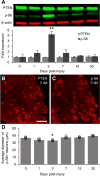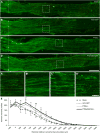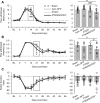Modest enhancement of sensory axon regeneration in the sciatic nerve with conditional co-deletion of PTEN and SOCS3 in the dorsal root ganglia of adult mice
- PMID: 29458059
- PMCID: PMC5864562
- DOI: 10.1016/j.expneurol.2018.02.012
Modest enhancement of sensory axon regeneration in the sciatic nerve with conditional co-deletion of PTEN and SOCS3 in the dorsal root ganglia of adult mice
Abstract
Axons within the peripheral nervous system are capable of regeneration, but full functional recovery is rare. Recent work has shown that conditional deletion of two key signaling inhibitors of the PI3K and Jak/Stat pathways-phosphatase and tensin homolog (PTEN) and suppressor of cytokine signaling-3 (SOCS3), respectively-promotes regeneration of normally non-regenerative central nervous system axons. Moreover, in studies of optic nerve regeneration, co-deletion of both PTEN and SOCS3 has an even greater effect. Here, we test the hypotheses (1) that PTEN deletion enhances axon regeneration following sciatic nerve crush and (2) that PTEN/SOCS3 co-deletion further promotes regeneration. PTENfl/fl and PTEN/SOCS3fl/fl mice received direct injections of AAV-Cre into the fourth and fifth lumbar dorsal root ganglia (DRG) two weeks prior to sciatic nerve crush. Western blot analysis of whole cell lysates from DRG using phospho-specific antibodies revealed that PTEN deletion did not enhance or prolong PI3K signaling following sciatic nerve crush. However, PTEN/SOCS3 co-deletion activated PI3K for at least 7 days post-injury in contrast to controls, where activation peaked at 3 days. Quantification of SCG10-expressing regenerating sensory axons in the sciatic nerve after crush injury revealed longer distance regeneration at 3 days post-injury with both PTEN and PTEN/SOCS3 co-deletion. Additionally, analysis of noxious thermosensation and mechanosensation with PTEN/SOCS3 co-deletion revealed enhanced sensation at 14 and 21 days after crush, respectively, after which all treatment groups reached the same functional plateau. These findings indicate that co-deletion of PTEN and SOCS3 results in modest but measureable enhancement of early regeneration of DRG axons following crush injury.
Keywords: Dorsal root ganglia; Nerve crush; PTEN; Regeneration; Ribosomal protein S6; SOCS3; Sciatic nerve; Stat3.
Copyright © 2018 Elsevier Inc. All rights reserved.
Figures






Similar articles
-
Impact of PTEN/SOCS3 deletion on amelioration of dendritic shrinkage of retinal ganglion cells after optic nerve injury.Exp Eye Res. 2020 Mar;192:107938. doi: 10.1016/j.exer.2020.107938. Epub 2020 Jan 21. Exp Eye Res. 2020. PMID: 31972211
-
Sustained axon regeneration induced by co-deletion of PTEN and SOCS3.Nature. 2011 Nov 6;480(7377):372-5. doi: 10.1038/nature10594. Nature. 2011. PMID: 22056987 Free PMC article.
-
Three-dimensional evaluation of retinal ganglion cell axon regeneration and pathfinding in whole mouse tissue after injury.Exp Neurol. 2013 Sep;247:653-62. doi: 10.1016/j.expneurol.2013.03.001. Epub 2013 Mar 16. Exp Neurol. 2013. PMID: 23510761 Free PMC article.
-
Lab review: Molecular dissection of the signal transduction pathways associated with PTEN deletion-induced optic nerve regeneration.Restor Neurol Neurosci. 2019;37(6):545-552. doi: 10.3233/RNN-190949. Restor Neurol Neurosci. 2019. PMID: 31839616 Free PMC article. Review.
-
Neuron-intrinsic inhibitors of axon regeneration: PTEN and SOCS3.Int Rev Neurobiol. 2012;105:141-73. doi: 10.1016/B978-0-12-398309-1.00008-1. Int Rev Neurobiol. 2012. PMID: 23206599 Review.
Cited by
-
Targeting the somatosensory system with AAV9 and AAV2retro viral vectors.PLoS One. 2022 Mar 10;17(3):e0264938. doi: 10.1371/journal.pone.0264938. eCollection 2022. PLoS One. 2022. PMID: 35271639 Free PMC article.
-
[Changes in expression of microRNA-221 and phosphatase and tension protein homologue in nerve stump after peripheral nerve injury].Zhongguo Xiu Fu Chong Jian Wai Ke Za Zhi. 2019 Sep 15;33(9):1162-1168. doi: 10.7507/1002-1892.201903122. Zhongguo Xiu Fu Chong Jian Wai Ke Za Zhi. 2019. PMID: 31512460 Free PMC article. Chinese.
-
Motoneuron-Specific PTEN Deletion in Mice Induces Neuronal Hypertrophy and Also Regeneration after Facial Nerve Injury.J Neurosci. 2022 Mar 23;42(12):2474-2491. doi: 10.1523/JNEUROSCI.1305-21.2022. Epub 2022 Feb 11. J Neurosci. 2022. PMID: 35149515 Free PMC article.
-
Transcriptomic sex differences in sensory neuronal populations of mice.Sci Rep. 2020 Sep 17;10(1):15278. doi: 10.1038/s41598-020-72285-z. Sci Rep. 2020. PMID: 32943709 Free PMC article.
-
Muscle-derived stem cell exosomes with overexpressed miR-214 promote the regeneration and repair of rat sciatic nerve after crush injury to activate the JAK2/STAT3 pathway by targeting PTEN.Front Mol Neurosci. 2023 May 26;16:1146329. doi: 10.3389/fnmol.2023.1146329. eCollection 2023. Front Mol Neurosci. 2023. PMID: 37305554 Free PMC article.
References
-
- Burfoot MS, Rogers NC, Watling D, Smith JM, Pons S, Paonessaw G, Pellegrini S, White MF, Kerr IM. Janus Kinase-dependent Activation of Insulin Receptor Substrate 1 in Response to Interleukin-4, Oncostatin M, and the Interferons. J Biol Chem. 1997;272:24183–24190. doi: 10.1074/jbc.272.39.24183. - DOI - PubMed
Publication types
MeSH terms
Substances
Grants and funding
LinkOut - more resources
Full Text Sources
Other Literature Sources
Molecular Biology Databases
Research Materials
Miscellaneous

